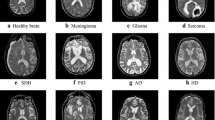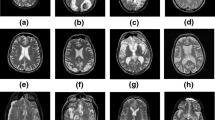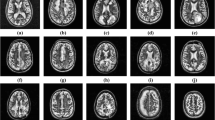Abstract
In this paper, a new approach for classification of brain tissues into White Matter, Gray Matter, Cerebral Spinal Fluid, Glial Matter, Connective and MS lesion in multiple sclerosis is introduced. This work considers fuzzy multiwavelets, Gaussian Mixture Model (GMM) and Weighted Probabilistic Neural Networks (WPNN) for the classification of the brain tissues. Multiwavelet packet transformation is employed on brain MR images. Since multiwavelet packet transformation yields larger number of subbands compared to multiwavelet and wavelet transformations, we have proposed a fuzzy-set based theory for selection of the subbands. In contrast to the standard method of subband selection, guided by the criteria of signal energy, our method is based on the discriminatory features from the multiwavelet packet transformation coefficients. Singular values are then computed from the selected subbands. The singular values of lower magnitudes are truncated for effective classification of brain tissues in the presence of noise. Probability density functions of the remaining singular values are modeled as GMM. Model parameters are estimated using stochastic EM (SEM). They are used as features for the classification. The classification is carried out using WPNN. Experiments have been carried out using the data sets composed of three modalities of brain MR images, namely T1 and T2 relaxation times and proton density weighted MR images. Experimental results prove that the proposed approach gives better classification rate at various noise levels compared to existing approaches.
Similar content being viewed by others
References
Ramakrishnan, S., & Selvan, S. (2006). Classification of brain tissues using multiwavelet transformation and probabilistic neural network. International Journal of Simulation: Systems, Science & Technology, 7(9), 9–25. A publication of the United Kingdom Simulation Society.
Leemput, K. V., Maes, F., Vandermeulen, D., Colchester, A., & Suetens, P. (2001). Automated segmentation of multiple sclerosis lesions by model outlier detection. IEEE Transactions on Medical Imaging, 20, 677–688.
Held, K. K., & Krause, B. J. (1977). Markov random field segmentation of brain MR images. IEEE Transactions on Medical Imaging, 16, 878–886.
Zhang, Y., Brady, M., & Smith, S. (2001). Segmentation of brain MR images through a hidden Markov random field model and the expectation-maximization algorithm. IEEE Transactions on Medical Imaging, 20(1), 45–57.
Ramakrishnan, S., & Selvan, S. (2007). Multiwavelet domain singular value features for image texture classification. Journal of Zhejiang University Science A, 8(4), 538–549.
Ramakrishnan, S., & Selvan, S. (2007). Multiwavelet based modeling for image texture classification. Advances in Modelling. Series B. Signal Processing and Pattern Recognition, 50(4), 64–84. A Publication of Association for the Advancement of Modelling and Simulation Techniques in Enterprises.
Coifman, R. R., & Wickerhauser, M. V. (1992). Entropy-based algorithms for best basis selection. IEEE Transactions on Information Theory, 38(2), 713–718.
Pedrycz, W. (1990). Fuzzy sets in pattern recognition. Pattern Recognition, 2, 121–146.
Pedrycz, W., & Vukovich, G. (2002). Feature analysis through information granulation and fuzzy set. Pattern Recognition, 35, 825–834.
Yang, Z.R., & Zwolinski, M. (2001). Mutual information theory for adaptive mixture models. IEEE Transactions on Pattern Analysis and Machine Intelligence, 23(4), 396–403.
Tsuji, T., Fukuda, O., Ichinobe, H., & Kaneko, M. (1999). A log-linearized Gaussian mixture network and its application to EEG pattern classification. IEEE Transactions on Systems, Man and Cybernetics. Part C. Applications and Reviews, 29(1), 60–72.
Ramakrishnan, S., & El Emary, I. M. M. (2009). Comparative study between traditional and modified probabilistic neural networks. International Journal of Telecommunication Systems, 40(1–2), 67–74.
El Emary, I. M. M., & Ramakrishnan, S. (2008). On the application of various probabilistic neural networks in solving different pattern classification problems. World Applied Sciences Journal, 4(6), 772–780.
Specht, D. F. (1990) Probabilistic neural networks. Neural Networks, 3, 109–118.
Mao, K. Z., Tan, K.-C., & Ser, W. (2000). Probabilistic neural-network structure determination for pattern classification. IEEE Transactions on Neural Networks, 11, 1009–1016.
Golub, G. H., & Van Loan, C. F. (1996). Matrix computations. Baltimore: John Hopkins Press.
Brain Web MR Simulator: Simulated Brain Data Base. http://www.bic.mni.mcgill.ca/brainweb/.
Whole Brain Atlas. http://www.med.harvard.edu.
Author information
Authors and Affiliations
Corresponding author
Rights and permissions
About this article
Cite this article
Ramakrishnan, S., El Emary, I.M.M. Classification brain MR images through a fuzzy multiwavelets based GMM and probabilistic neural networks. Telecommun Syst 46, 245–252 (2011). https://doi.org/10.1007/s11235-010-9287-1
Published:
Issue Date:
DOI: https://doi.org/10.1007/s11235-010-9287-1




